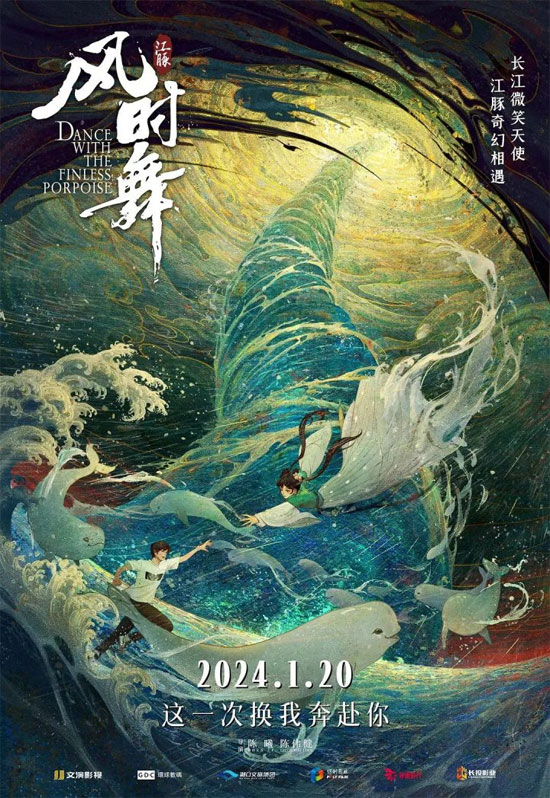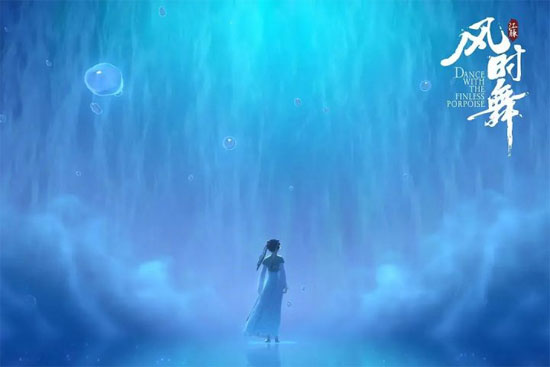Film Name: 江豚·風時舞 / Dance With the Finless Promise / Dance With the Wind
Dance With the Finless Promise, an animated film, depicts the ecological devastation of the modern Yangtze River. Jiang Ling, a dolphin fairy tasked with saving her kind, ventures into the human world and encounters a boy named Lin Sheng, reigniting a century-spanning bond. Despite the trailer emphasizing environmentalism, romance, and traditional Chinese aesthetics, audiences expressed disappointment with the film. This article analyzes the issues with “Dance With the Finless Promise” and proposes appropriate improvements.
First, the film’s environmental message is flawed. While it touches on protecting finless porpoises, it only superficially introduces them, using the porpoises merely as a vehicle to tell a love story. Moreover, the film portrays the “water dragon calamity” as caused by the dolphins themselves—a human-versus-dolphin narrative that contradicts animal conservation ethics. To authentically convey wildlife protection, creators should first study dolphin behavior and physiology to genuinely safeguard them. Films like Finding Nemo excel in this regard by showcasing marine creatures’ habits and characteristics, fostering audience empathy and conservation instincts.

Secondly, the romantic storyline in “Dance With the Finless Promise” is clichéd and unoriginal. The century-spanning love between the protagonists fails to resolve the audience’s doubts, as the male lead treats the female lead merely as a tool to fulfill his mother’s wish. This setup prevents viewers from genuinely understanding why they fell in love, ultimately reducing their affection to a hollow arrangement. When crafting the romance, the film could have delved deeper into the reasons behind the protagonists’ affection, fostering greater audience resonance with their bond and narrative.
Finally, “Dance With the Finless Promise” falls short in its execution of traditional Chinese aesthetics. While audiences hold high expectations for such animations, this film fails to meet those standards. From character design to narrative details, it lacks thorough research into traditional Chinese aesthetics. For instance, the character designs lean toward contemporary otome mobile games, presenting an overall style reminiscent of poorly crafted games. Additionally, the dance design for “Wind Time Dance” deviates significantly from traditional Chu Kingdom aesthetics, and even the soundtrack features mismatched instruments like the guzheng and pipa.

To address the issues in “Dance With the Finless Promise,” targeted improvements are essential. First, the subject matter should emphasize animal conservation details, delving into the ecology of finless porpoises to foster audience understanding and a desire to protect wildlife. Second, the romantic storyline must more intricately depict the protagonists’ love and mutual growth, enabling viewers to resonate with their emotional journey. Finally, in terms of traditional Chinese aesthetic production, more diligent research into its characteristics and details is needed to ensure the work authentically embodies this style.
In summary, while “Dance With the Finless Promise” possesses commendable intentions, it falls short in its environmental message, romantic narrative, and traditional Chinese aesthetic execution. Audiences hold high expectations and standards for traditional Chinese-style animation, making it imperative to elevate production quality and dedicate genuine effort to refining the work—ensuring compelling content and noble themes are seamlessly integrated. Only by addressing these shortcomings can traditional Chinese-style animation achieve genuine growth.
Please specify:Anime Phone Cases » Dance With the Finless Promise 2024 Film Review: disappointed the crowd